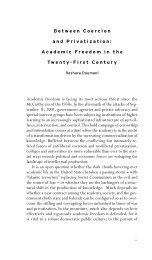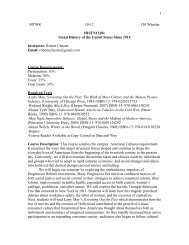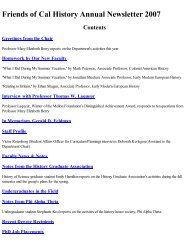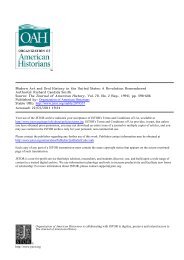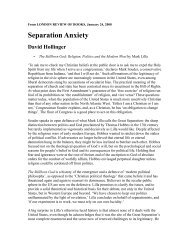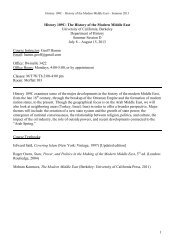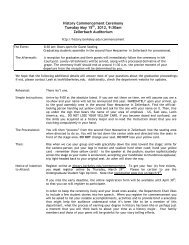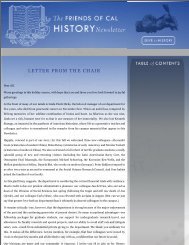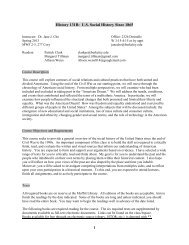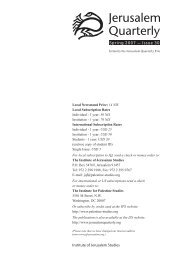David A. Hollinger | Amalgamation and Hypodescent: The Question ...
David A. Hollinger | Amalgamation and Hypodescent: The Question ...
David A. Hollinger | Amalgamation and Hypodescent: The Question ...
Create successful ePaper yourself
Turn your PDF publications into a flip-book with our unique Google optimized e-Paper software.
peoples that "the great Alchemist" would eventually make into one: "Celt <strong>and</strong> Latin, Slav <strong>and</strong> Teuton, Greek <strong>and</strong> Syrian—black <strong>and</strong>yellow"; Israel Zangwill, <strong>The</strong> Melting-Pot (New York, 1909), 199.15 Ê Ralph Waldo Emerson, Journals <strong>and</strong> Miscellaneous Notebooks (Cambridge, Mass., 1960–82), 11: 299–300.16 Ê Matthew Frye Jacobson, Whiteness of a Different Color: European Immigrants <strong>and</strong> the Alchemy of Race (Cambridge, Mass.,1998).17 Ê Slavery continued in Cuba until 1884 <strong>and</strong> in Brazil until 1888.18 Ê For an accessible, pointed discussion of the ambiguities of "Indianness," including an account of the popular practice of claiminga fractional Indian ancestry, almost always through one's gr<strong>and</strong>mother, see P. S. Deloria <strong>and</strong> Robert Laurence, "What's an Indian?"Arkansas Law Review 44 (1991), rpt. in Johnson, Mixed Race, 312–18.19 Ê See the tables of the federal census as conveniently available in Norman R. Yetman, Majority <strong>and</strong> Minority: <strong>The</strong> Dynamics ofRace <strong>and</strong> Ethnicity in American Life, 6th edn. (Boston, 1999), 88.20 Ê Such cases of attempted white-to-black reclassification, while rare, are not unknown. <strong>The</strong>y are often discussed in relation tominority-eligible entitlement programs. This phenomenon is addressed in Luther Wright, Jr., "Who's Black, Who's White, <strong>and</strong> WhoCares," V<strong>and</strong>erbilt Law Review 48 (1995), rpt. in Johnson, Mixed Race, 181–83.21 Ê <strong>The</strong> st<strong>and</strong>ard history of the principle of hypodescent in the United States is F. James Davis, Who Is Black? (University Park, Pa.,1991). A readable popular account that increased public awareness is Lawrence Wright, "One Drop of Blood," New Yorker (July 25,1994): 46–55.22 Ê Barbara Fields, "Ideology <strong>and</strong> Race in American History," in Morgan Kousser, et al., Region, Race, <strong>and</strong> Reconstruction (NewYork, 1982), 149.23 Ê For the case of the Seminoles, see "Who Is a Seminole, <strong>and</strong> Who Gets to Decide?" New York Times (January 29, 2001): 1.24 Ê A recent example is the summary discussion by <strong>David</strong> Parker <strong>and</strong> Miri Song in the introduction to their edited collection,Rethinking "Mixed Race" (London, 2001), 13–14. A cogent account of the different histories of ethnoracial categorization <strong>and</strong>related public policies in Brazil, South Africa, <strong>and</strong> the United States is G. Reginald Daniel, "Multiracial Identity in GlobalPerspective: <strong>The</strong> United States, Brazil, <strong>and</strong> South Africa," in Loretta I. Winters <strong>and</strong> Herman L. DeBose, eds., New Faces in aChanging America: Multiracial Identity in the 21st Century (Thous<strong>and</strong> Oaks, Calif., 2003), 247–86.25 Ê See the comments on this issue by Christine B. Hickman, "<strong>The</strong> Devil <strong>and</strong> the 'One Drop' Rule," Michigan Law Review 95 (1997),rpt. in Johnson, Mixed Race, 104–10.26 Ê Alexis de Tocqueville, Democracy in America, Harvey C. Mansfield <strong>and</strong> Delba Winthrop, trans. <strong>and</strong> ed. (Chicago, 2000), 590.27 Ê For a detailed account of the legal history of hypodescent prior to its sharpening in the early twentieth century, see Michael A.Elliott, "Telling the Difference: Nineteenth-Century Legal Narratives of Racial Taxonomy," Law <strong>and</strong> Social Inquiry 24 (1999): 611–36. For a similarly detailed account of the history of the U.S. Census's engagement with mixture from 1790 to the present, see AnnMorning, "New Faces, Old Faces: Counting the Multiracial Population Past <strong>and</strong> Present," in Winters <strong>and</strong> DeBose, New Faces, 41–67.28 Ê Mark Twain, Pudd'nhead Wilson (Hartford, Conn., 1894).29 Ê <strong>The</strong> text of the Virginia "Act to Preserve Racial Integrity" is available in Sollors, Interracialism, 23–24. <strong>Hypodescent</strong>, it shouldbe acknowledged, was not universally applied in all states even after 1924. Louisiana law, for example, was always more responsiveto degrees of African descent than the laws of most other states. <strong>The</strong> inconsistencies of efforts to impose fractional definitions in thelaws of various states is a major theme of Teresa Zackondik, "Fixing the Color Line: <strong>The</strong> Mulatto, Southern Courts, <strong>and</strong> RacialIdentity," American Quarterly 53 (September 2001): 420–51.30 Ê <strong>The</strong> definitive work on the literary history of black-white mixing is Werner Sollors, Neither Black nor White yet Both: <strong>The</strong>matic



